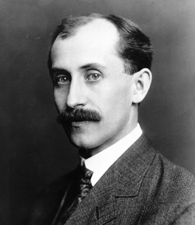Orville Wright was a leading aviation pioneer of the early 20th century. He and his older brother Wilbur are credited for being the first to successfully build and fly a heavier-than-air machine that could lift off the ground, a breakthrough that led to the modern airplane.
Orville Wright’s Early Days
Orville Wright was born in Dayton, Ohio, on August 19, 1871. He was the fourth of seven children born to a bishop and his wife, a loving family that was very receptive to pursuing creative and intellectual interests.
His brother Wilbur was four years his senior, but they did practically everything together. Orville, who never enjoyed the classroom setting, dropped out of high school to open up a bicycle shop with Wilbur.
In 1896, Orville and his brother read about Otto Lilienthal, a German scientist who had been experimenting with gliders and crashed. The attempt piqued the brothers’ curiosity. They eventually decided to contact the Smithsonian Institution to find out anything they possibly could about flying. The Weather Bureau recommended Kitty Hawk, N.C., as the perfect place for testing.
Sources in this story
- NASA: Biography of Orville Wright
- Time: Heroes: Begetter of an Age
- Wright House: Wright Brothers History: First Airplane Flight
- The New York Times: Earliest Days: Takeoff! How the Wright Brothers Did What No One Else Could
- Wright Brothers Aeroplane Company: The Wright Story
- Encyclopedia Britannica: Wilbur and Orville Wright
- National Parks Service: Dayton Aviation Heritage: Orville Wright’s Life Story
Wright’s Aviation Feats
Orville and Wilbur experimented with kites and gliders for several years, advancing their understanding of how to work with controlling airborne objects. While other inventors sought to build “inherent stability” into their flying machines, the Wright House Web site explains that the Wright Brothers developed ways for the pilot to keep the airplane stable in flight and make controlled turns.
After setting up camp at Kill Devil Hills on the Outer Banks of North Carolina, Orville and his brother began testing out airplanes that they had built. On December 17, 1903, Orville and Wilbur Wright finally succeeded in demonstrating powered flight. On the first test of the day, Orville flew 120 feet in 12 seconds. Wilbur’s flight lasted longer, taking him 852 feet in 59 seconds.
The New York Times reports that one of the few witnesses, a young boy named Johnny Moore, ran down the beach shouting, “They done it, they done it, damned if they ain’t flew!”
Many people still wonder how Orville and his brother, two relatively simple men from a small town, could perform such an amazing feat. There had been scientists and hopeful aviators trying for years to reach the successes achieved by the Wrights.
After their first flight and subsequent flights witnessed by large crowds, the two brothers rose to great fame. In 1907, the Wrights sold an airplane to the United States Army Signal Corps and in 1908, a French syndicate bought another plane.
The brothers organized a company to build and sell airplanes in 1909, with Wilbur acting as president. After several lawsuits and struggles over patent rights, however, the two brothers were in over their head. They could not adapt to the pressures and stresses of the ruthless business world.
In 1912, an overwrought Wilbur contracted typhoid and died, leaving a reluctant Orville as president of the Wright Company. He remained president until he sold his interest in the company in 1915.
The Rest of the Story
With business anxieties and legal issues behind him, Orville left the airplane industry and dedicated his time to his true passion, inventing. He remained one of the most famous Americans of his time, receiving awards and honorary degrees from universities and organizations in America and Europe. He also was also an active member of the National Advisory Committee for Aeronautics, now NASA, for 28 years.
Orville Wright died on January 30, 1948, from a heart attack. Wright, along with his brother, remains a preeminent figure in early aviation and will always be remembered for his contributions to the field.











